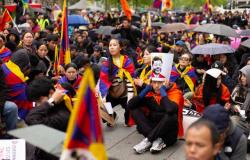
While some of Kiev’s needs will be met by US military aid unblocked by Congress, the combat power crisis remains unresolved. The Ministry of Defense has already launched an ambitious campaign to convince volunteers, but some experts warn that Kiev must start a serious mobilization if it wants to solve the severe shortage of troops, writes Reuters.
Ukrainian soldier in front of a recruitment poster Photo: Sergei SUPINSKY / AFP / Profimedia
“The most important source of Ukrainian weakness is the lack of combat power,” Konrad Muzika, director of the Rochan military consulting company in Poland, explained to Reuters the other day.
It’s an important observation, and increasingly so, at a time when the US Congress has finally unblocked military aid to Kiev, and long-awaited weapons and ammunition are about to arrive on the front lines.
After months of debate, a new mobilization law signed by Volodymyr Zelenskiy on April 16 comes into effect in May, aiming to make the recruitment process faster, more transparent and more efficient.
But the new recruits will need months of training before they can be deployed to the front, providing a “window of opportunity” that Russia can exploit, Muzika said.
“I would expect the situation to probably continue to deteriorate over the next three months,” he said, but added that things should improve from autumn.
There is still enough until autumn. Ukraine’s military needs a “massive” influx of personnel to lock down Russian forces on the entire front, Muzika said, adding that a separate recruitment drive to enlist volunteer fighters would not be enough to cover the shortfall.
A European security source also said, according to Reuters, that Ukraine must step up its mobilization effort.
None of the camps involved in the conflict publishes official data on military strength and exact losses.
Andrii Yusov, a spokesman for Ukraine’s military intelligence services, said Russia, which controls 18 percent of Ukrainian territory, has between 450,000 and 470,000 soldiers fighting in Ukraine, in addition to the 35,000 members of the national guards, such as and the separate air force and naval operations that take place.
Kiev has said in the past that it has around 1 million men under arms, obviously not all of them on the front lines.
In December, Zelenskiy said the army, under Valeri Zalujnîi, wanted to mobilize up to half a million new soldiers. Ukraine’s new supreme commander said after taking over in February that a “significantly reduced” number would be needed.
A post in the army. By choice
The initial wave of volunteers who rushed into the army after the February 2022 invasion has dried up. The government has admitted that its recruitment drive has run into difficulties, with thousands trying to abscond, with some people trying to flee or even fleeing abroad rather than risk the trenches.
The law, which takes effect next month, forces men to update their enlistment data with authorities and should, in theory, increase the number of soldiers. But things will go slowly.
So while efforts to recruit enough men are stymied by public skepticism, defense officials and military units have begun to launch a multi-frontal persuasion offensive.
The recruitment campaign runs on job sites and information centres, as well as through billboards and social media, and offers a wartime novelty: an element of choice.
For example, applicants can select their exact unit and roles that match their skills, as well as length of military service.
On city streets, billboards with Ukrainian soldiers implore citizens to enlist and defend their homeland.
Online, the 93rd Mechanized Brigade assures its compatriots that “everyone can do it!”, in a video campaign showing civilians taking on roles in the army – a tractor driver who becomes a tank driver, for example.
Deputy Defense Minister Natalia Kalmikova told Reuters that military planners recognized that in a democratic country, offering options could be key to attracting people to the military.
“The people who are coming now to defend our country are not those who chose the military career: they are civilians,” Kalmikova said during an interview in Kiev. “And civilians are used to being able to choose,” she explained.
“Somewhere the trust was lost”
Thirteen of the new recruitment centers have been opened since mid-February, and the government plans to expand the number to 30 by mid-year, Oleksii Bejeveț, an adviser to the ministry overseeing the campaign, told Reuters.
At the first center, in Lviv, approximately 300 people came to visit in the first month, Bejeveț said, without specifying whether any of them signed up for the army. The Ministry of Defense is also working with four private recruitment companies to fill vacant military positions, he added.
He acknowledged the plans were not a “magic pill” for the military, although he said the range of roles to be filled was so wide that it didn’t matter so much what people chose.
“The main purpose is to give people the opportunity to overcome their fears and enter the military sphere,” the official said.
Ukraine’s recruitment drive, launched in the wake of the invasion, has been hampered by local media reports of corruption, official abuses and administrative incompetence. Then social media was flooded with clips of officers picking people up off the street or raiding homes.
Common concerns about military service include inadequate training, weak commanders and the fact that there is no time limit on the length of military service, according to a survey conducted in February by Kiev-based research agency Info Sapiens for media publication Texty. org.
In the survey of 400 eligible men, only 35% of them said they were ready to serve if called up.
“Somewhere, at some point, trust was lost,” said Bejeveț, the adviser to the defense minister. “Right now, our task is to renew it,” he added.
Zelenski acknowledged shortcomings in mobilization when he fired the heads of regional recruitment offices last August, citing reports of corruption and official abuse.
Real mobilization is needed, experts say
Bejeveț stated that the objective of the recruitment campaign of the Ministry of Defense is to triple the number of volunteers who enlist. In the long term, he added, at least a third of Ukraine’s armed forces should be staffed by voluntary conscription.
As part of the campaign, the Ministry of Defense has started working with four major job sites, the official said, adding that so far about 100,000 candidates have responded to more than 10,000 advertised vacancies.
Lobby X, one of the sites, offers an easy-to-use platform that allows job seekers to search by military branch, from Marine Corps to Military Intelligence, and by job category, from gunner to cook or press officer.
Like any regular job posting, job vacancies list responsibilities, requirements and benefits, including monthly pay, which ranges from about $500 to $3,000. And volunteer contracts can be signed for specific terms starting from three years, or until the end of martial law.
The goal, said Lobby X CEO Vladislav Greziev, is to allow people to choose exactly the unit they want to serve in and make the most of their skills.
Michael Kofman, a military specialist at the Carnegie Endowment for International Peace think tank, warned, however, that while this recruitment drive is positive for the military, it will not be a decisive solution to a severe troop shortage that would could only be fully resolved by mobilization.
“Hundreds of thousands of men are probably needed to support the fight – especially infantry, for which few are likely to volunteer, as that is where most casualties are sustained,” he added.
Business cards in camouflage colors
Several Ukrainian military formations have launched or stepped up their own public relations campaigns, and more and more billboards promoting individual units have appeared in cities.
Among the most important is the 3rd Separate Assault Brigade, which perfected its recruiting tactics over the course of a war in which it excelled on the battlefield.
The all-volunteer unit has become famous for its stylish social media presence, which includes spectacular clips from the front and frequent appearances by fighters with colorful stories.
Last month, Reuters accompanied several members on a leg of a tour of several regions of Ukraine to promote the brigade, educate civilians about military service and recruit new members.
At a social service center in the central Ukrainian town of Kropivnitsk, soldiers from the brigade took turns answering questions from passers-by and would-be recruits and offering them places on a free training course to test their mettle.
Over two days in Kropivniţkîi, about 20 people have agreed to attend the week-long course, according to one of the soldiers with the callsign “Loft,” a heavily tattooed fighter who carries camouflage-colored business cards with his personal number .
At a high school in the city, two other fighters spoke to the youth, warning them of the grim realities of war and stressing the importance of discipline and training.
One of them, who identified himself as Bull, said the brigade’s distinct nationalist ideology meant its success in attracting recruits might not be easily replicated. But frequent and honest information would be key to making military service a desirable path for more Ukrainians as the war drags on, he added.
“We are playing a long-term game,” the military warned.
Tags: weapons Ukraine massive influx troops crucial time war strategy attract
-




